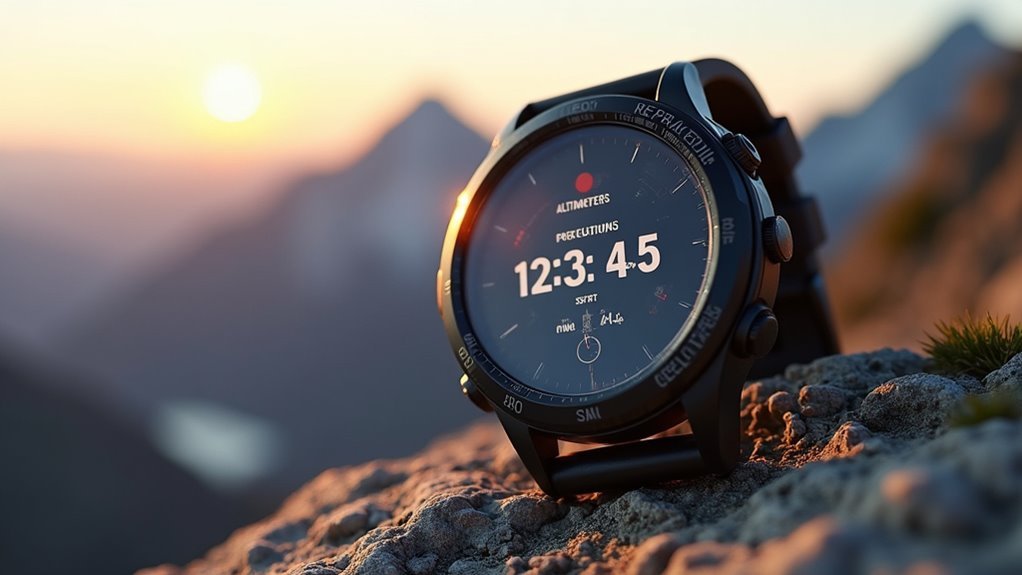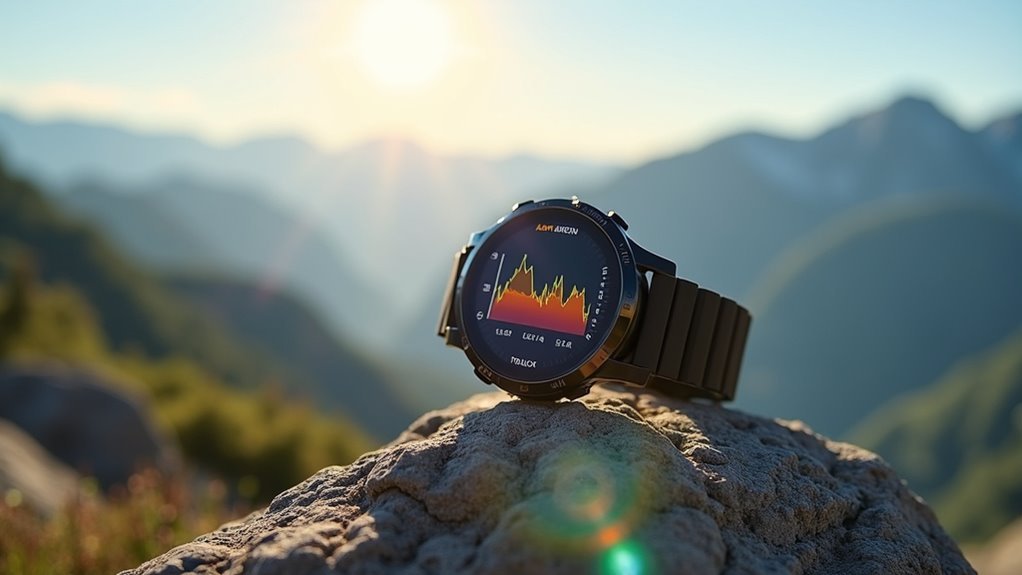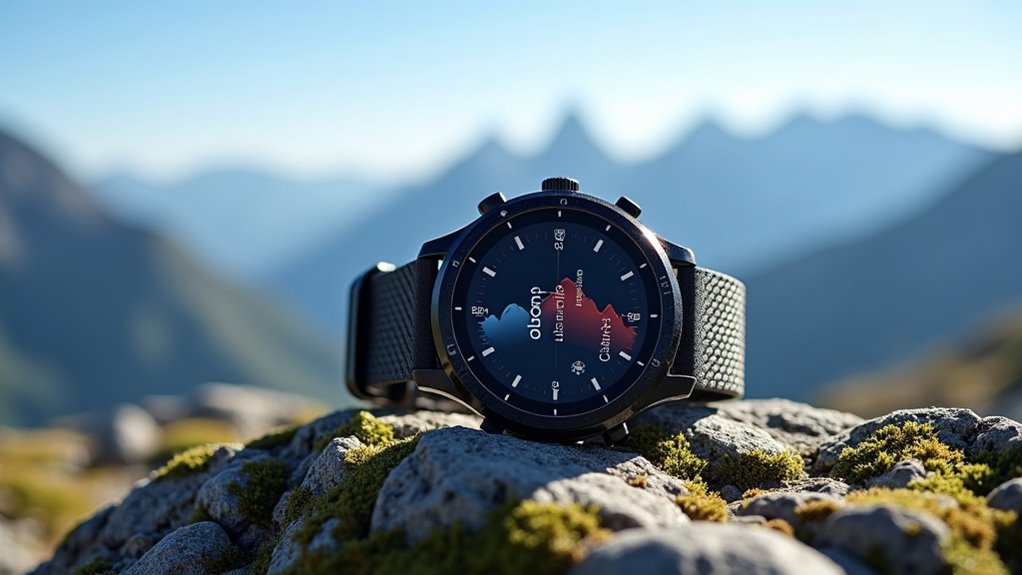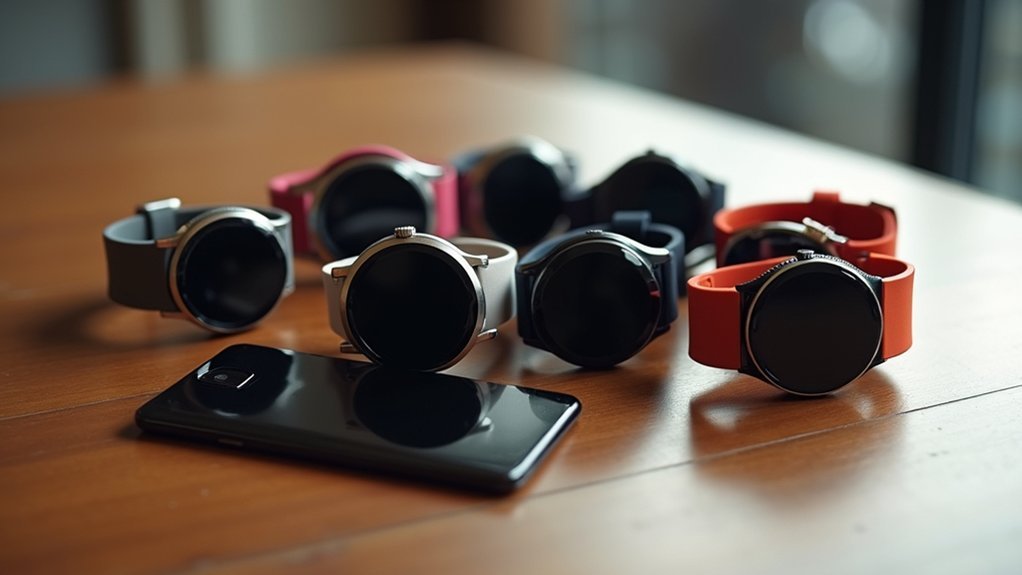You’ll want a multisport watch that combines barometric altimeters with multi-constellation GPS tracking for the most accurate altitude measurements. Look for models supporting GPS, GLONASS, GALILEO, and BEIDOU satellites that can connect to 32 satellites simultaneously for enhanced precision. The best features include automatic calibration systems, solar charging for extended GPS runtime, weather monitoring integration, and customizable altitude displays. Advanced fusion algorithms merge barometric and GPS data to optimize your outdoor adventures.
Barometric Altimeter Precision and Calibration Systems

When you’re tracking altitude during outdoor adventures, barometric altimeters serve as the cornerstone technology in multisport watches, measuring elevation changes through air pressure variations rather than relying solely on GPS coordinates.
You’ll need to recalibrate these sensors frequently to maintain accuracy, as environmental factors like temperature and humidity affect readings. Weather conditions can greatly impact your altimeter’s precision, making manual adjustments essential when you’re at known elevations.
High-quality sensors deliver more stable readings, but you’ll still face calibration challenges during fast-paced activities. Many devices offer terrain-specific settings that let you adjust altitude readings based on your environment, ensuring you get the most reliable data for navigation and performance tracking.
Professional-grade multisport watches like the COROS APEX 2 Pro incorporate advanced barometric systems that provide enhanced altitude precision for serious athletes and mountaineers.
GPS Integration and Multi-Satellite Constellation Support
While barometric altimeters provide the foundation for elevation tracking, GPS integration with multi-satellite constellation support transforms your multisport watch into a thorough navigation powerhouse.
You’ll benefit from multi-GNSS tracking that combines GPS, GLONASS, GALILEO, QZSS, and BEIDOU satellites for enhanced accuracy in challenging environments like mountains or urban canyons. Your watch can connect to up to 32 satellites simultaneously across four constellations, dramatically reducing GPS dropouts during complex terrain navigation.
The GPS altitude range typically spans from -500m below sea level to nearly 10,000m elevation, with vertical accuracy around one meter. Most modern multisport watches maintain accuracy within 1-3% of actual measured distance even in challenging canyon environments.
Advanced fusion algorithms merge GPS altitude data with barometric readings, delivering smooth altitude profiles that enable precise calculation of total ascent, descent, and real-time vertical speed for trail running, climbing, and cycling activities.
Battery Performance and Solar Charging Capabilities

Although GPS tracking delivers precise altitude data, it’s also the most demanding feature on your multisport watch’s battery, making power management and solar charging capabilities critical differentiators between models. You’ll find significant variations in endurance across different watches, with solar charging providing substantial benefits for extended outdoor adventures.
| Watch Model | Standard GPS Hours | Solar-Enhanced GPS Hours |
|---|---|---|
| COROS VERTIX 2S | 118 hours | N/A (no solar) |
| Garmin Enduro 3 | 120 hours | 320 hours |
| Garmin fenix 8 Solar | 95 hours | 149 hours |
| COROS PACE 3 | 38 hours | N/A (no solar) |
| Garmin Instinct 2X Solar | 60 hours | 145 hours |
Solar charging becomes particularly valuable during multi-day expeditions where you’re tracking altitude continuously, effectively doubling your GPS runtime under ideal sunlight conditions. The Garmin Enduro 3 specifically features three months of battery life per charge when solar technology is utilized, making it ideal for extreme outdoor adventures requiring extended altitude tracking.
Display Technology and User Interface Design
Beyond raw performance metrics, your multisport watch’s display technology and interface design directly impact how effectively you can access and interpret altitude data during demanding outdoor activities.
AMOLED displays deliver vibrant colors and high resolution, ensuring you’ll clearly read elevation profiles even in bright sunlight. Always-on functionality with ambient light sensors preserves battery while maintaining visibility.
You can customize dashboards to prioritize altitude metrics, creating sport-specific screens through companion apps. Widgets provide instant access to elevation alerts and training load data. Advanced models feature solar-charging lens technology that extends battery life significantly during extended outdoor activities.
Responsive touchscreens enable seamless navigation through altitude tracking features, while high sensitivity works reliably with gloves or wet fingers. Intuitive interface design integrates altitude, GPS, and heart rate data without cluttering your view during intense activities.
Weather Monitoring and Advanced Altitude Analytics
Modern multisport watches integrate barometric altimeters with sophisticated weather monitoring systems, transforming your device into an extensive environmental analysis tool.
You’ll receive elevation data in three-foot increments while tracking barometric pressure trends over 3-6 hours to predict weather changes. Storm warnings generate automatically from these pressure patterns, keeping you informed during high-intensity activities.
Advanced models like the Garmin Instinct 3 Tactical offer wind meter compatibility for thorough weather analytics.
You’ll access detailed elevation graphs, cumulative gain/loss statistics, and terrain steepness analysis for enhanced route planning. Dual-band GPS combines barometric data with satellite positioning, reducing elevation errors to just 8-9 feet on recent Garmin and Apple models.
Your watch also provides altitude-adjusted VO2 max estimates and monitors sunrise/sunset times alongside real-time weather trends for peak outdoor performance. Premium models feature AMOLED displays with topographic mapping capabilities for enhanced visual navigation in challenging terrain conditions.
Frequently Asked Questions
How Do Altitude Tracking Watches Perform During Underwater Activities Like Swimming or Diving?
You’ll find altitude tracking doesn’t work underwater since barometric sensors can’t read air pressure and GPS signals don’t penetrate water effectively, so watches typically switch to depth measurement modes instead.
Can Multisport Watches Track Altitude Accurately in Extreme Temperatures or Arctic Conditions?
You’ll find multisport watches can track altitude accurately in arctic conditions down to -22°F. However, extreme temperatures may affect sensor precision, so you’ll need proper calibration and barometric-GPS combinations for peak performance.
Do Altitude Sensors Require Special Maintenance or Cleaning After Muddy Trail Runs?
You should clean altitude sensors promptly after muddy runs. Soak your watch in warm soapy water, gently brush away debris, rinse thoroughly, and use compressed air to clear sensor ports completely.
How Does Watch Weight Affect Comfort During Ultra-Marathon or Multi-Day Events?
You’ll experience less muscle fatigue and wrist strain with lighter watches during ultra-marathons. Heavy watches alter your arm swing, increase energy expenditure, and create distracting pressure points that can impair focus over multi-day events.
Are Altitude Tracking Features Compatible With Third-Party Fitness Apps and Platforms?
You’ll find most multisport watches sync altitude data seamlessly with platforms like Strava, TrainingPeaks, and Apple Health through companion apps, exporting elevation profiles, ascent totals, and gradient information in standard formats.
In Summary
You’ll find that the best multisport watches combine precise barometric altimeters with robust GPS systems to deliver accurate altitude data during your adventures. You can’t go wrong with models that offer extended battery life, solar charging, and clear displays that work in all conditions. Don’t overlook weather monitoring features and advanced analytics—they’ll help you make smarter decisions on the trail and track your performance improvements over time.





Leave a Reply